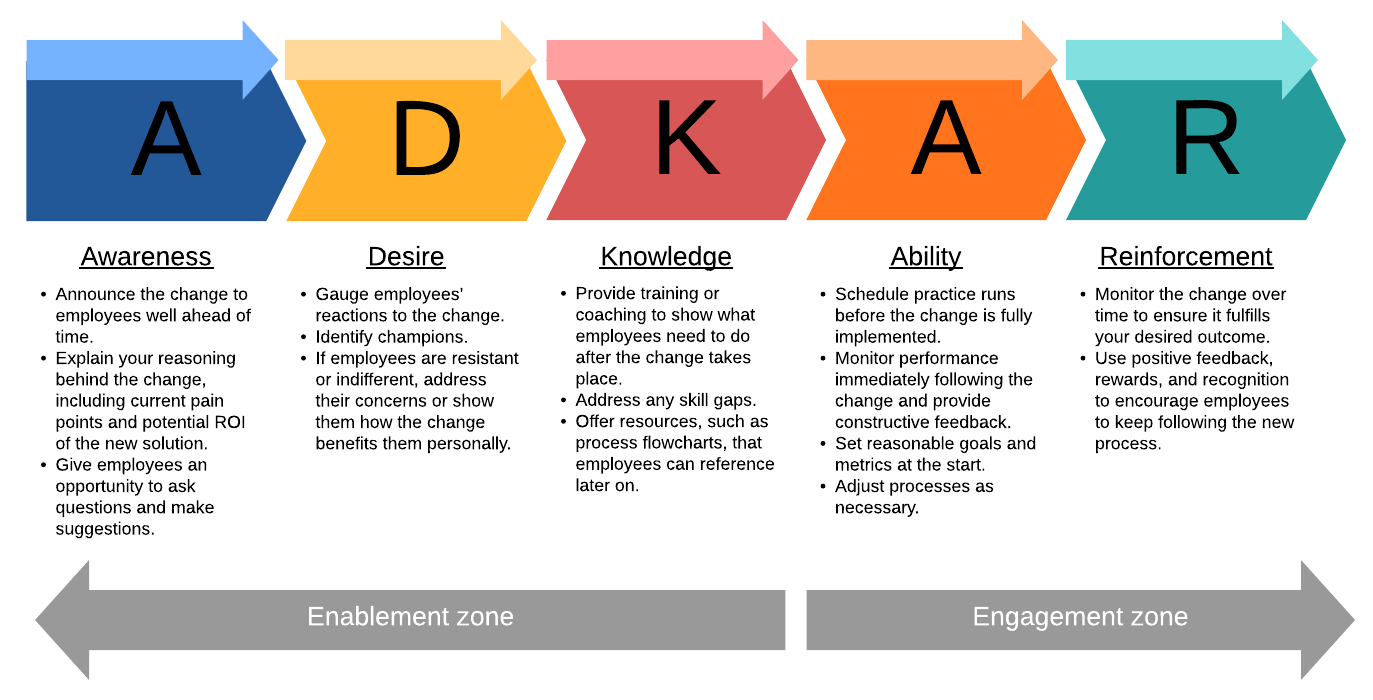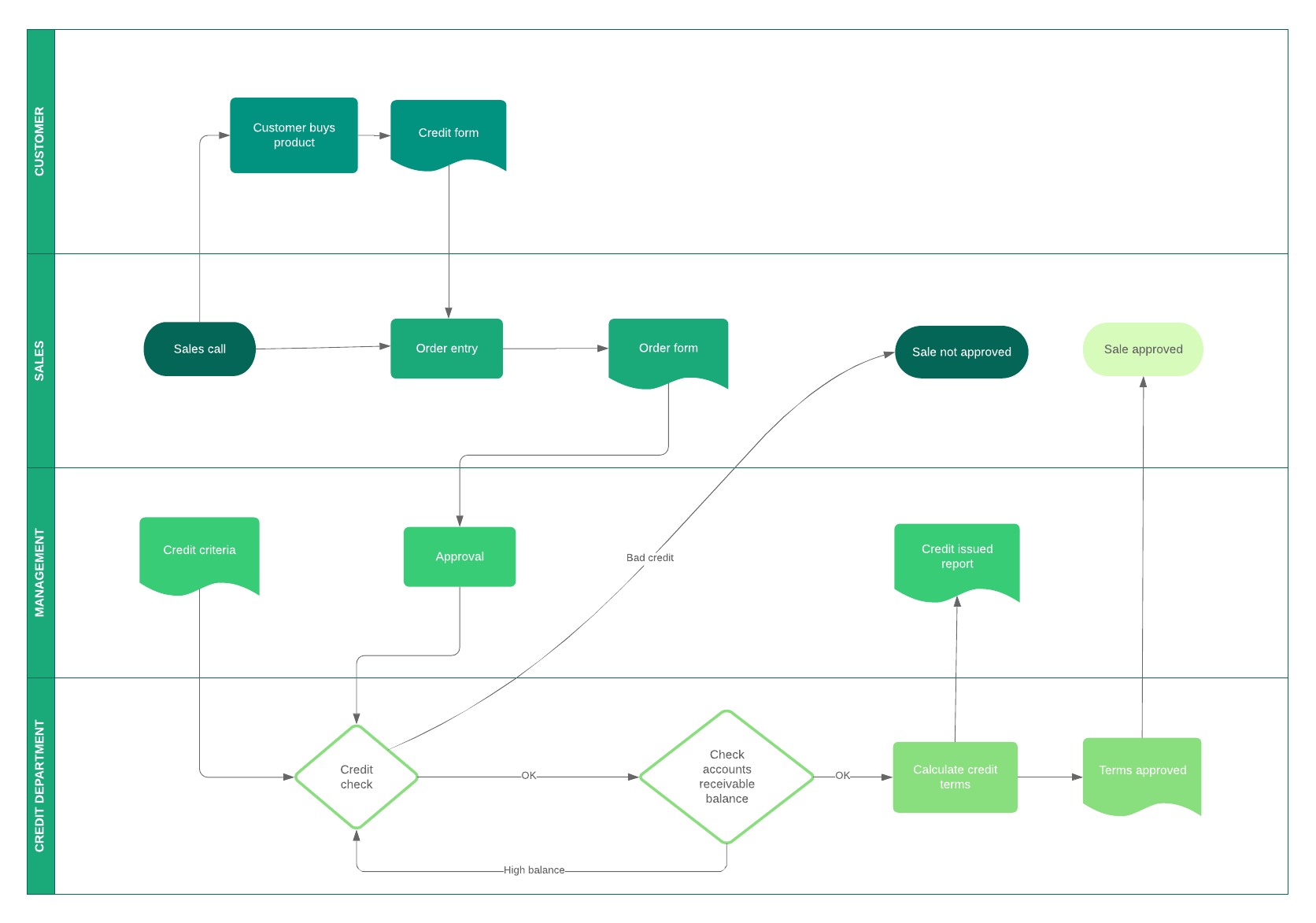Change is often necessary so that a company remains relevant and continues to deliver viable solutions to a growing customer base. But, while a company and its executives may recognize the need for change management, employees may be resistant since change can be difficult and uncomfortable.
The attitude of “But this is the way we always do it” can be difficult to overcome—but luckily, there are tried-and-true methods to make change happen with less resistance. Created by Jeff Hiatt, founder of Prosci, the ADKAR change model has been proven to help individuals understand and accept change so companies can successfully innovate and become more efficient.

What is the ADKAR model?
Developed in the ’90s, the ADKAR change management model is based on the analysis of hundreds of successful and unsuccessful organizational changes over the course of many years.
The ADKAR change model includes the following building blocks:
A: Awareness: Make employees aware of the change.
D: Desire: Instill a desire to change.
K: Knowledge: Teach employees how to make the change.
A: Ability: Leverage knowledge into the ability to make the change.
R: Reinforcement: Make the change permanent by reinforcing new methods.
Let’s explore these five building blocks in more detail to help you understand how to implement the ADKAR model and facilitate individual and organizational change. The successful implementation of ADKAR depends on individuals having a clear understanding of what the changes are, why the changes are coming, and how the changes will affect them.
Awareness
Your employees need to be aware that change is coming. The less they know about an upcoming change, the more resistant they will likely feel.
Consider the following scenario, based on a true story, as an example:
An employee named, Kate, is busily typing in order to meet a close-of-business deadline. A member of the company’s facilities team, Dave, walks into Kate’s cubicle and says, “Here are some boxes for your move.”
“What?” asks a surprised Kate.
Dave says, “I was told that you are moving to the new building.”
The building Kate currently works in is only five minutes from her house. The new building is an hour away.
Kate asks her manager, Brad, what is going on. Brad, embarrassed, says, “Oh, yeah. Hey, Kate, do you have a minute to talk?”
As you can imagine, Kate was a little bit resistant to the idea of having to move and adding an hour to her commute.
Change is inevitable and often will take people out of their comfort zones. In this scenario, Kate was blindsided by a change that was going to be inconvenient for her. Brad needed to inform Kate about the change long before Dave showed up with boxes so she could pack up for the move. In addition, Brad could have shared some reasoning behind the change. For example, maybe all development of the product she worked on was being moved to the new site in an effort to facilitate a more agile environment.
Bottom line: Explain your reasoning behind the change well ahead of time so employees are more willing to accept and prepare for it.

TUTORIAL
Raise awareness by showing the current and future state of your business processes.
Learn howDesire
Your employees may understand why the change needs to be made—but that doesn’t mean that they will want to make the change.
If members of your organization understand the need for change and honestly believe it will be beneficial, you will see an enthusiastic response as they work hard to implement the change to work toward goals. This is the next step of the ADKAR model.
If they don’t fully support the change, the desire to participate won’t be there and you'll meet passive, or even active, resistance. You may need to help them through the change process until they feel more comfortable with it. Gauge their reactions to recognize their level of desire.
Passive resistance may mean employees don’t see why a change is necessary, but they will most likely comply when it is convenient for them. They also may fall back into old methods when you are not around.
Others may actively resist the change. This is not necessarily a bad thing. It may be because you didn’t adequately explain the reasons and rationale behind the change. That’s why it’s important to answer the “What’s in it for me?” (WIIFM) question early and often in your communications. Prosci’s 2019 benchmarking study found that 47% of the employee resistance they encountered could have been avoided by implementing effective change management practices and principles.
To prevent resistance from the start:
- Work with your team and encourage open discussion so that they will buy in to the change
- Recruit support from senior leaders to advocate for the change
- Communicate the need for change and answer WIIFM early and repeatedly
Bottom line: Be aware of your employees’ feelings, and do your best to address their fears or show them how the change benefits them personally.
Knowledge
You won’t get far in your change management initiative if your employees are not equipped with the knowledge they need to make and sustain change. The more knowledge and training you can give, the more employees will understand the change and see the benefits of making it—and the easier it will be to transfer that knowledge during the next step in the ADKAR change management process.
Prosci’s ADKAR model emphasizes two main types of knowledge for change management:
- Knowing how to make the change (e.g. what to do during transition)
- Knowing how to perform in the future state (e.g. the skills to support the change)
To build this knowledge, employees will need training and education, experience, access to information, and mentoring. For example, if the change will require new processes and procedures, provide adequate training and mentoring to ensure that operations will run smoothly. Document these processes to provide a clear resource for employees to reference so they are more likely to follow best practices. Visual documentation, such as process flowcharts, can help throughout this stage.
Bottom line: Train your team and provide resources about new procedures and best practices so employees can successfully implement the change when the time comes.

Ability
Just because your team understands the change doesn’t mean that they will have the ability to perform their roles right away.
For example, imagine you’re a child taking swimming lessons. In theory, you probably understand that you need to kick your legs and move your arms to propel yourself across the water. But in practice, it’s a lot more difficult. It takes practice swimming in shallow water with flotation devices before you get used to swimming on your own.
To translate knowledge to ability, you need to have some practice runs and analyze what goes well and what doesn’t. Make adjustments where necessary and try again. Be a mentor and offer constructive feedback and always look for ways to improve and streamline.
Bottom line: Monitor employees as they start implementing the changes so you can provide constructive feedback and improve the new process.
Reinforcement
After you've made the change and your workflows are running smoothly, reinforcement is a crucial step of the ADKAR model that ensures that people don’t revert to old methods. It takes some time for people to completely adopt a change—a study from the British Journal of Health Psychology suggest it takes a median of 59 days to form a habit.
The more complex the activity, the longer it can take. So if you want your workforce to buy in to the changes that have been implemented, you need positive reinforcement to keep them on track and productive. Reinforcement can come in the form of recognition and rewards, performance measures, and positive feedback to show that the change is here to stay.
In addition, you can use the reinforcement stage of the ADKAR model to look for areas where new processes aren’t working or where bottlenecks have formed in the process, causing stress and anxiety. Those who previously supported the change may turn against it and revert to an old workflow in an effort to meet deadlines and goals.
Don’t wait for processes to fail or for your employees to crack. Use workflow diagrams and flowcharts to identify problem areas and work with your team to find solutions. Working your way through problems and finding solutions visually can help you reinforce the idea that you and the company are committed to the implemented changes.
Bottom line: The ADKAR change model doesn’t stop with implementation. To see your desired results, you need to monitor the change over time and encourage employees to keep following it.
Other change management models
The ADKAR model is not the only way to manage organizational and individual change. If this model doesn’t suit your organization’s needs, look at these other change management models developed to help you to make effective changes in your company.
The ADKAR change management model may be all you need to successfully manage change, but it doesn’t hurt to explore other models to find the one (or the combination of models) that will work for you.

Explore Lucidchart to see what else it can do for your team.
Go nowAbout Lucidchart
Lucidchart, a cloud-based intelligent diagramming application, is a core component of Lucid Software's Visual Collaboration Suite. This intuitive, cloud-based solution empowers teams to collaborate in real-time to build flowcharts, mockups, UML diagrams, customer journey maps, and more. Lucidchart propels teams forward to build the future faster. Lucid is proud to serve top businesses around the world, including customers such as Google, GE, and NBC Universal, and 99% of the Fortune 500. Lucid partners with industry leaders, including Google, Atlassian, and Microsoft. Since its founding, Lucid has received numerous awards for its products, business, and workplace culture. For more information, visit lucidchart.com.
Related articles
How to implement change with Kotter’s 8-step change model
Learn all about Kotter's 8-step change model, including how to successfully implement it to get buy-in and make new or adapted processes stick.
7 fundamental change management models
Change management generally refers to how teams and companies implement organizational change. Learn 7 tried-and-true change management models that organizations return to again and again.
What is organizational development: All about process, goals, and benefits
Learn all about the organizational development process, including its process, goals, and benefits. Includes templates!

